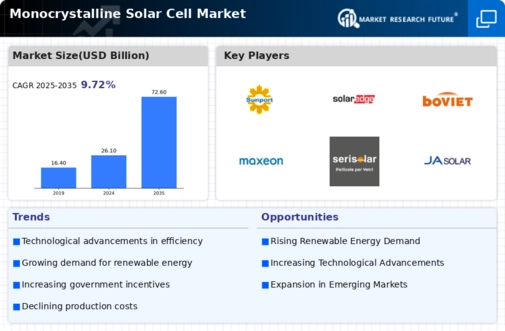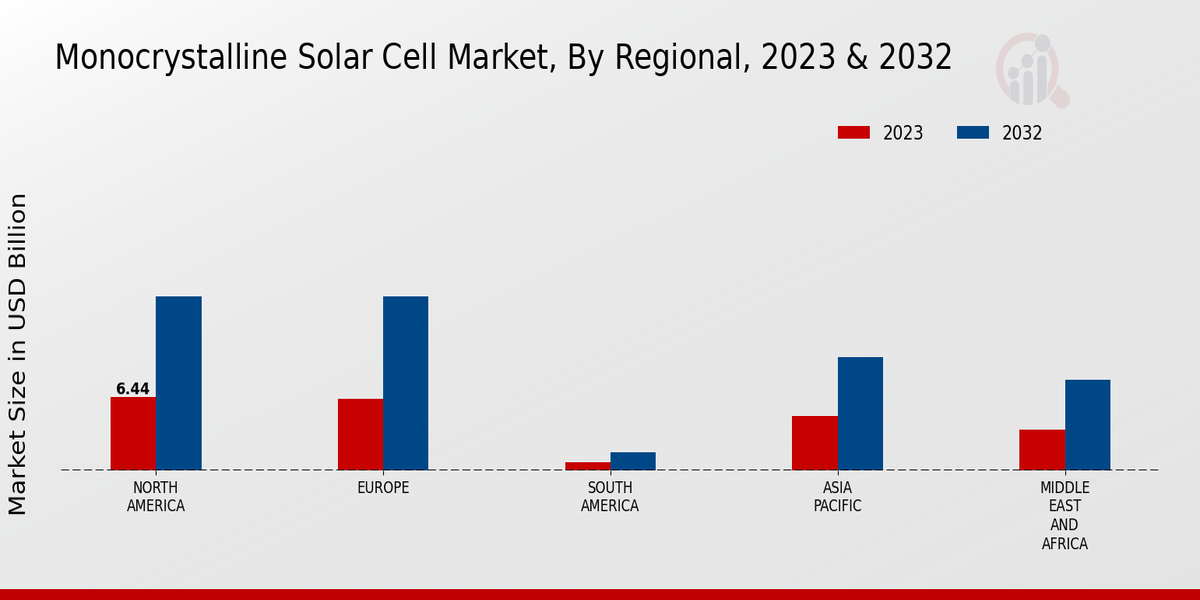Rising Energy Costs
The rising costs of traditional energy sources significantly influence the Global Monocrystalline Solar Cell Market Industry. As fossil fuel prices fluctuate and become increasingly volatile, consumers and businesses are seeking more stable and predictable energy solutions. Solar energy, particularly from monocrystalline cells, offers a long-term cost-effective alternative. The ability to generate electricity on-site reduces reliance on grid power, which is subject to price hikes. This shift towards solar energy is reflected in the market's anticipated growth, with a projected value of 72.6 USD Billion by 2035, driven by the need for energy independence and cost savings.
Market Growth Projections
The Global Monocrystalline Solar Cell Market Industry is poised for substantial growth, with projections indicating a market value of 26.1 USD Billion in 2024 and an anticipated increase to 72.6 USD Billion by 2035. This growth trajectory suggests a compound annual growth rate of 9.72% from 2025 to 2035, highlighting the increasing adoption of solar technologies. The expansion is driven by various factors, including technological advancements, government incentives, and rising energy costs. As the market evolves, it is likely to attract further investments and innovations, reinforcing its position as a critical component of the global energy landscape.
Technological Advancements
Technological innovations in the Global Monocrystalline Solar Cell Market Industry are pivotal in enhancing efficiency and reducing costs. Recent advancements in cell design, such as bifacial solar panels and PERC technology, have led to improved energy conversion rates. For example, the efficiency of monocrystalline solar cells has reached levels exceeding 22%, making them more competitive against other solar technologies. These improvements not only attract investments but also encourage wider adoption among consumers and businesses. As technology continues to evolve, the market is likely to see further enhancements that could drive growth and lower the overall cost of solar energy systems.
Government Incentives and Subsidies
Government incentives and subsidies play a crucial role in the Global Monocrystalline Solar Cell Market Industry, fostering the adoption of solar technologies. Many countries offer tax credits, rebates, and grants to encourage residential and commercial installations of solar panels. For instance, the U.S. federal solar tax credit allows homeowners to deduct a significant percentage of the cost of solar systems from their federal taxes. Such financial incentives lower the barrier to entry for consumers, thereby stimulating market growth. As these programs continue to evolve, they are likely to enhance the attractiveness of solar energy, contributing to the projected market growth.
Increasing Demand for Renewable Energy
The Global Monocrystalline Solar Cell Market Industry experiences a robust demand driven by the global shift towards renewable energy sources. Governments worldwide are implementing policies to reduce carbon emissions, which enhances the appeal of solar energy. For instance, the International Energy Agency indicates that solar energy could account for a significant portion of the global energy mix by 2030. This trend is reflected in the projected market value of 26.1 USD Billion in 2024, with expectations to reach 72.6 USD Billion by 2035. The compound annual growth rate of 9.72% from 2025 to 2035 further underscores the increasing reliance on solar technologies.
Environmental Awareness and Sustainability
Growing environmental awareness and a focus on sustainability are key drivers in the Global Monocrystalline Solar Cell Market Industry. Consumers are increasingly prioritizing eco-friendly products and practices, leading to a surge in demand for renewable energy solutions. This shift is evident in the rising number of corporate sustainability initiatives, where companies commit to reducing their carbon footprint. The adoption of solar energy aligns with these goals, as it provides a clean and renewable source of power. As public consciousness around climate change and environmental issues continues to rise, the market for monocrystalline solar cells is likely to expand, reflecting these changing values.


























Leave a Comment